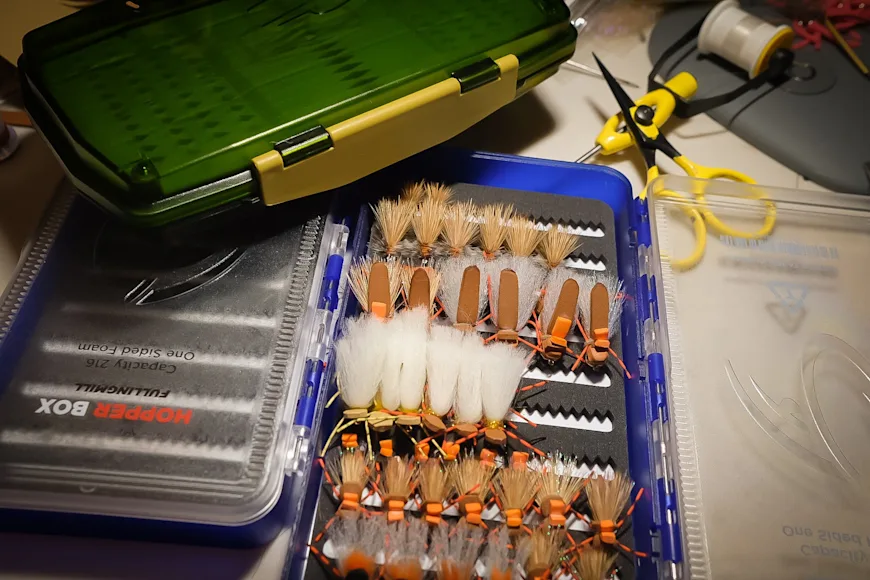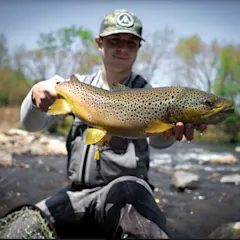_We may earn revenue from the products available on this page and participate in affiliate programs. Learn more ›
_
Best Overall
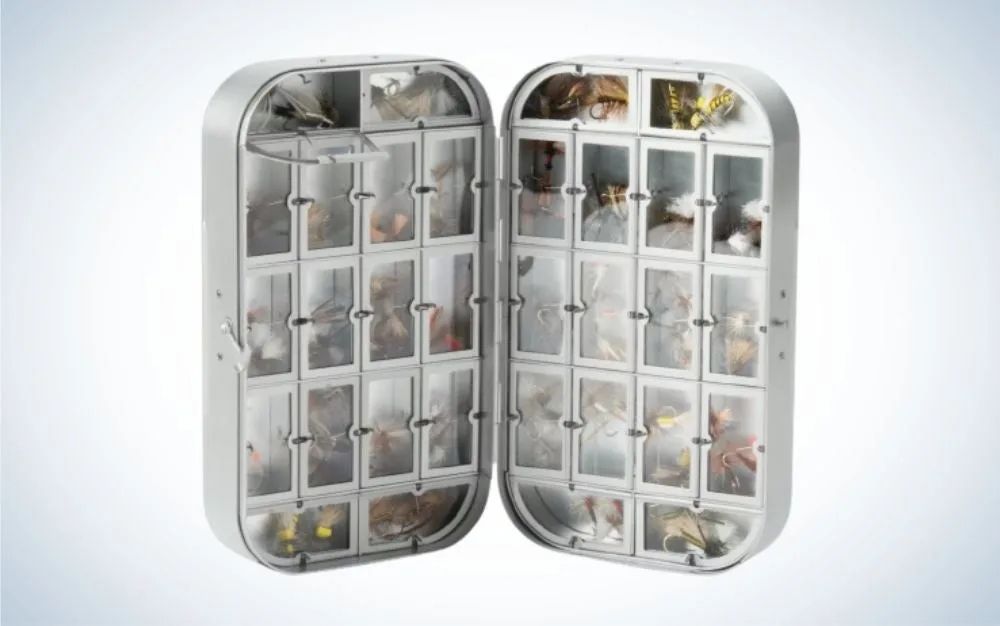
Wheatley Signature Box
LEARN MORE
Summary
The ultimate fly box for dry fly purists with strong construction and numerous compartments. It holds any size fly without damaging hackles.
Best Silicone
Tacky Pescador
LEARN MORE
Summary
From the creators of the original silicone insert fly box, the Tacky Pescador-Large holds more than enough flies with plenty of space to keep them looking new.
Best Capacity
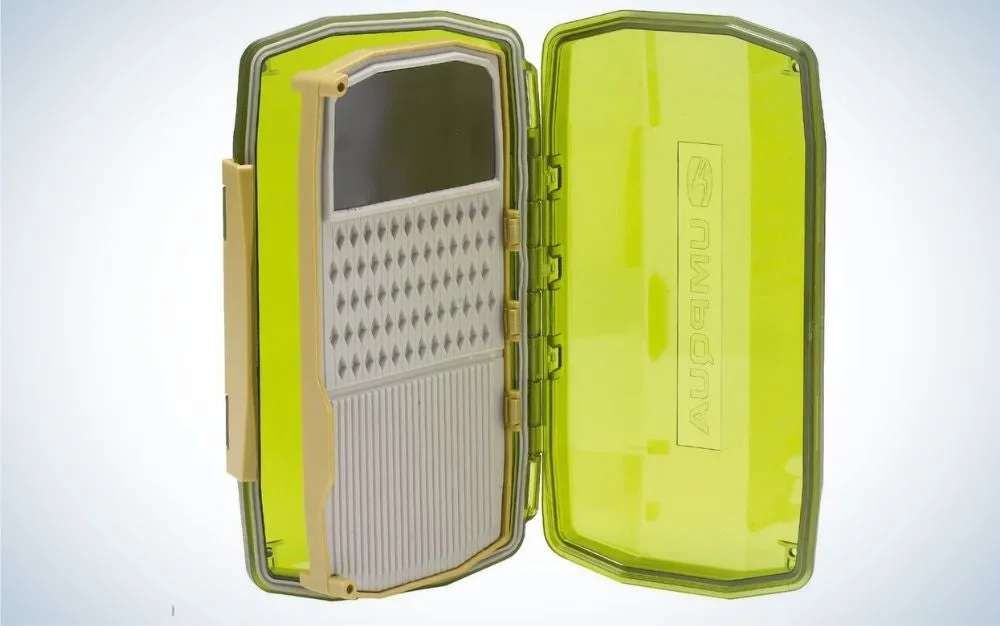
UPG HD Weekender
LEARN MORE
Summary
Umpqua’s UPG HD Weekender is the most versatile fly box for all types and sizes of dry flies as well as an assortment of nymphs.
Dry fly boxes are a necessity for any fisherman regularly fishing dry flies. These delicate flies need room in a box to keep their hackles from compressing to float properly. Time and time again I’ve seen great flies ruined in the wrong box. With this in mind, it’s much easier to choose the proper box to store your precious dry flies. A good box should have plenty of room below the fly so the hackles have space, come with enough storage for multiple patterns and sizes, and have sturdy inserts that last for years on the river. If you fish Catskill-style dry flies, this is especially important. Designed with specific proportions, the fly floats because the hackles and tail keep the fly on top of the water. If the hackles are pressed down, they will take memory and ultimately sink faster than properly stored flies. To help keep your flies looking like new here are a few recommendations for the best dry fly boxes.
Best Overall: Wheatley Signature Box
Best Silicone: Tacky Pescador
Best Capacity: UPG HD Weekender
Best Magnetic: Fulling Mill Hopper Box
Best Budget: OriGlam Premium 20 Compartment Fly Box
Best Overall: Wheatley Signature Box
Best Overall

Why it Made the Cut: The ultimate fly box for dry fly purists with strong construction and numerous compartments. It holds any size fly without damaging hackles.
Key Features:
Insert Material: Compartments
Fly Storage: 32 compartments
Closure System: Metal latch
Pros:
Compartments keep flies separate
Sturdy box
Aluminum construction
Cons:
Expensive
Most fly boxes are constantly changing with new trends and new materials, but one has stayed true to its origins for generations. The Wheatley Signature Box is a classic that arose in 1908 and has remained a staple ever since. Rather than relying on an insert to hold flies, the 32 compartments keep flies organized by size and type. The added space for the flies prevents the hackles from matting down and the clear windows allow you to see into the compartments. I remember my grandfather cherishing his Wheatley box and the delicate flies in it. For anglers fishing fast water where bushy dries or Catskill style flies’ fish best, this box is a must. These intricate flies are designed so the hackles and tail keep the hook just above the water for a natural presentation. On wary fish, storing your flies properly can mean the difference between a great day and a mediocre one. The only downside is this box comes with a price tag, but for those who like compartment-style boxes, the quality is undeniable.
Best Silicone: Tacky Pescador-Large
Best Silicone
Why it Made the Cut: From the creators of the original silicone insert fly box, the Tacky Pescador-Large holds more than enough flies with plenty of space to keep them looking new.
Key Features:
Insert Material: Silicone slotted insert
Fly Storage: 238 fly slots
Closure System: Magnetic closure
Pros:
Waterproof
You can add a middle leaf for double the storage
Easy magnetic closure
Cons:
Slightly big for smaller-sized dry flies
Tacky revolutionized the fly box industry with the silicone fly insert. For the first time, there was an insert that held flies securely and had no memory of the hook when you took out the fly. Fast forward and the Tacky Pescador-Large features the same silicon material with added features any fly angler should have. At first glance, the box is easy to open with magnetic closures and a rubberized gasket for waterproof protection. Inside the box is where it shines—the double-sided box has enough slots to hold 238 flies. With that said I typically skip a slot when storing fragile dry flies to keep their hackles separated. The large box is taller so you can close it with no worries of flies pressing against one another. My favorite feature is the raised rows for fly storage. Not only does this make it easier to take flies out of the box but it gives them room underneath to keep their original shape. If you fish dry droppers or a lot of parachute-style flies and prefer more storage an additional center divider can be purchased to double storage.
Best Capacity: UPG HD Weekender
Best Capacity

Why It Made the Cut: Umpqua’s UPG HD Weekender is the most versatile fly box for all types and sizes of dry flies as well as an assortment of nymphs.
Key Features:
Insert Material: Silicone insert
Fly Storage: N/A
Closure System: Latch system
Pros:
Magnetic pad for small dries or midges
Large slots for big hoppers and terrestrials
Secure waterproof design
Cons:
Over time the clear outside will scuff and fade
Known for bringing unique and effective fly patterns to the masses, Umpqua’s lineup of fly boxes is frequently overlooked. Yet, the UPG HD Weekender is one of the best all-around fly boxes I’ve ever laid eyes on. Featuring various size fly slots and a magnetic pad for smaller flies you can truly store any fly imaginable. This box gives you the ability to bring an arsenal of flies to the river. It is especially good when you don’t know what to expect. I fill mine full of hoppers, parachute flies, an assortment of nymphs, and even a couple of streamers. The tall sides and big slots have plenty of room for larger flies. It really shines for technical tailwater fisheries where the magnetic pad allows you to store small midges and dries for when the fish are keying in on the tiniest bugs. A silicone gasket and front latch keep the box secure and fully waterproof in case you drop it. Just be careful if you’re in heavy current because the box will float if you’re not quick.
Best Magnetic: Fulling Mill Hopper Box
Best Magnetic
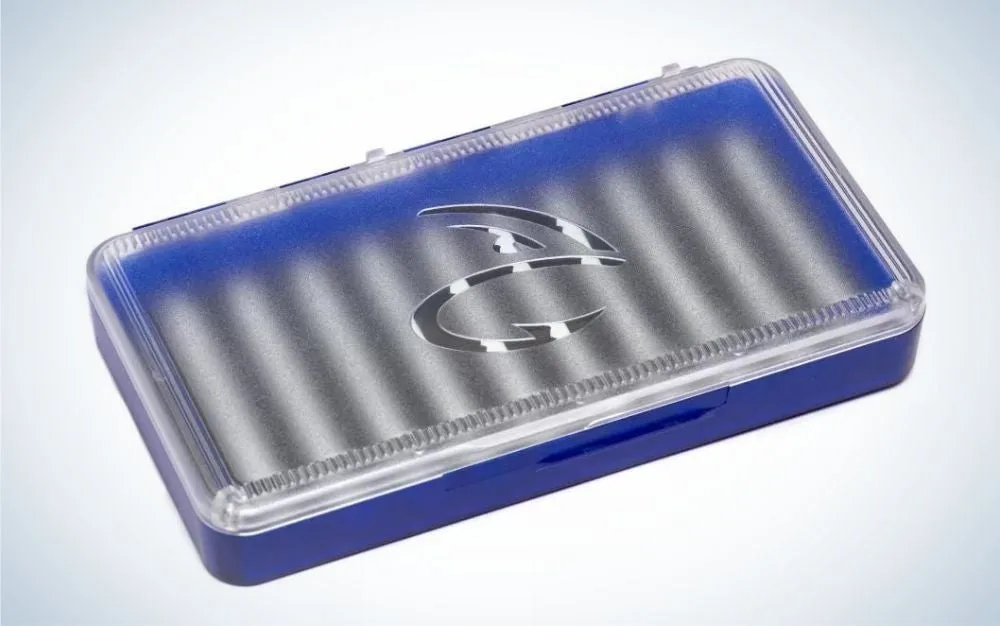
Why it Made the Cut: This simplistic design is the perfect box for summertime fishing when hoppers and terrestrials are a trout’s preferred meal.
Key Features:
Insert Material: Foam insert
Fly Storage: 216 fly slots
Closure System: Magnetic Closure
Pros:
Easy to open
Plenty of space for large foam flies
Sleek profile
Cons:
Foam inserts will hold memory
Fulling Mill is a household name in the competitive world of fly fishing, known for its hooks and flies. Staying true to its roots the Hopper Box is a sleek, lightweight box perfect for competitive anglers and enthusiasts looking for a solution to dry fly storage. The magnetic closure is simple to use and makes for quick fly changes on the water. As a dedicated terrestrial box, you can fit several patterns in an assortment of colors and sizes. I like to fill mine with an assortment of foam and natural material terrestrial patterns to cover any scenario. Angler’s that typically fish smaller dry flies still feel right at home with this box. The added height and openings between slotted sections protect flies from being damaged. A clear but texturized top also allows you to peek in the box before you open it while remaining fairly scratch resistant. For an affordable and reliable workhorse of a box, the Fulling Mill Hopper Box is a great choice.
Best Budget: OriGlam Premium 20 Compartment Fly Box
Best Budget
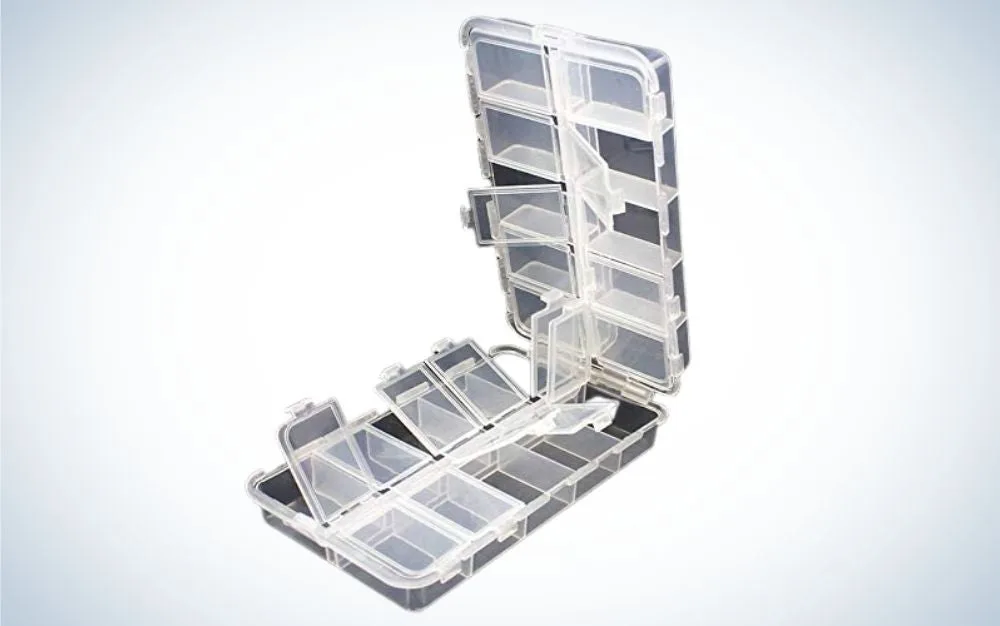
Why it Made the Cut: An economical option for anglers wanting a compartment-style fly box to hold a variety of dry flies.
Key Features:
Insert Material: Compartment-style box
Fly Storage: 20 Compartments
Closure System: Plastic Latch
Pros:
Budget-friendly
Won’t crush flies
Can see into the box
Cons:
Not as many compartments as in other boxes
While it’s certainly not a Wheatley Box, this no-frills compartment-style box is great for anyone on a budget or just starting out. This was the first compartment box I ever used and it still comes with me to the river. With 20 individual compartments, you can choose the files you want without others spilling them out. Each section has a small plastic tab that clicks into place when closed. The front latch is a swing style that securely keeps the box from folding open. While it doesn’t have a ton of storage, each compartment has enough room for at least a half dozen flies depending on their size. At this price point, it’s hard to find a better option to hold dry flies. That being said, it is not waterproof, so make sure you dry out the flies if you take a spill or you’ll run into rust down the road.
Things to Consider Before Buying Dry Fly Boxes
Unfortunately, not all fly boxes are created equal. They all serve their purpose and must be paired with the proper flies. The other half of the battle is choosing a box that is user-friendly and designed to take the abuse of the river. As you progress as an angler you will naturally develop preferences of what style box works best for you. To help narrow down the decision, keep in mind box durability, capacity, and design to find a perfect box.
Durability
The life of a fly box is not an easy one. They drop in rivers, bounce off rocks, and take the brunt of the elements. The most durable boxes are built with hard plastic or aluminum shells. These boxes can take their fair share of abuse while functioning like new. An often-overlooked feature is the insert design. Silicon inserts will hold flies securely even when dropped. The last feature I look for is the closure system on a box. Latch-style systems are great for keeping your box closed in case you fumble. If you prefer magnetic closures for quick access, make sure the magnets are strong enough to keep the box closed.
Capacity
Depending on where you fish and the number of hatches you get, it can seem impossible to carry enough flies. Having a box with plenty of storage allows you to carry a variety of patterns in different sizes. This can make a difference on the river when the fish are keying in on a particular bug. Some boxes are single-sided, but depending on the box size, can offer a fair bit of storage. Double-sided boxes offer more storage but come with added width if the size is an issue. Choose a box based on your storage needs and the style of your pack or vest to get the most out of the box.
Design
Dry fly boxes come in two main designs, slotted boxes and compartment boxes. Slotted boxes are the most common style of box, but any box designed for dries should have enough room to not damage the hackles. Compartment-style boxes are designed to keep any part of the fly from being damaged. Individual compartments can keep flies organized by type or size. Most boxes have enough slots to store two dozen different patterns and plenty of storage for any hatch that might happen.
FAQs
Q: What is the best size for a dry fly box?
Dry fly box size depends on the type and style of flies you plan on fishing. For anglers fishing hatches where mayflies and caddis are the most common, a smaller box will suffice. These patterns don’t take up a ton of space so a smaller box is more than enough for a variety of patterns. Anglers fishing hopper patterns or a cicada hatch should lean towards larger boxes. The added room of large fly boxes allows anglers to fit larger flies easily without overcrowding them. If you have a hard time finding a dry fly-specific box, most streamer boxes will also work for these bigger flies.
Q: What is the difference between a dry fly and a nymph?
Dry flies are designed to be fished on the surface of the water while nymphs are subsurface flies. A dry fly imitates aquatic insects that swim to the surface and hatch from the water. These flies typically feature stiff and bushy hackles to float on the water’s surface. Most nymphs on the other hand feature some sort of weight or bead-head to allow them to sink to the bottom where trout do a majority of their feeding.
Q: What line to use for dry flies?
Anglers fishing dry flies will want to use a floating weight forward fly line. The floating line is necessary to keep the fly on top of the water where the fish will eat it. The weight forward portion of the line means the majority of the line’s weight is in the front section of the line. This gives the caster power to shoot the line as the heavier weight forward end carries the fly towards its target. Another popular line is a double taper line which is great for smaller streams with shorter casting distances. Double taper lines excel at roll casting and can be beneficial on small mountain streams where the overhanging brush is an issue.
Q: How do I fix hackles on my dry flies?
If you stored your dry flies in the wrong box and the hackles are matted down there is still hope to recover them. Steam works surprisingly well at returning hackles and hair to their original shape. Simply heat a kettle of water until it begins to steam. Then with a long pair of pliers or tongs hold a fly in the steam for a few seconds. The hackles should begin to straighten out and return to normal. Your flies may not return to exactly how you bought them but they will be in fishing condition once again.
Final Thoughts
Every angler wants to take care of the flies they bought or tied. Choosing one of the best dry fly boxes is an important part of protecting your flies. Depending on the style and sizes of dry flies you fish, some boxes may work better than others. Taking the time to look at box design, fly storage, and overall durability can help narrow down the decision. Keep this in mind and your flies will be ready to go next time an epic hatch happens on the river.
Methodology
As an avid fly angler and former fly shop employee, I’ve seen my fair share of fly boxes. Every box has its pros and cons but knowing when to use it is the most important. Not all fly boxes work for every fly, and with the price of flies these days, storing them properly is a must. Dry flies, more so than other flies, are intricate and delicate, requiring extra room in a fly box to keep them looking new. While there are plenty of ways to achieve this, the best boxes have plenty of room for the hackles, hold an adequate number of flies, and hold up against long days on the water. I based my decisions on the following criteria:
Insert type: What insert does the box have and how well does it hold flies?
Waterproofness: Is the box waterproof in case you drop it?
Quality: How well-built is the box?
Capacity: Can the box hold enough flies for a variety of situations?
Closure system: How does the box close and is the design durable?
Design: What design features does the box incorporate to store dry flies without damaging them?

